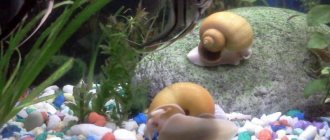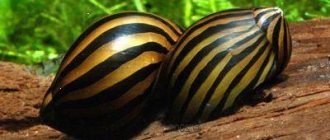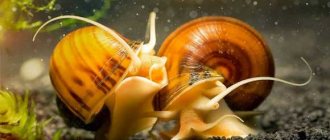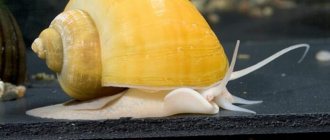Snails live in many aquariums with a diverse "population". Them, which filter water and free it from food debris, particles of dead algae, and fish waste. Not every snail caught in a neighboring pond is able to adapt to the “new life” (vegetation, composition and quality of water, temperature, lighting). Therefore, river snails in an aquarium should be in the environment to which they are accustomed.
Population control
So, we have established that snails have a role in the aquarium and are unlikely to eat your fish or plants, but their numbers should still be controlled. Below are several ways to control snail populations:
Fish
As mentioned earlier, some fish species, such as cyclids, eat snails. Of course, before purchasing, it is vital to do independent research and find out for any species of fish - whether predator or not - whether they are suitable for your current aquarium, its size and water composition, and whether they are compatible with the fish living in the aquarium.
Feed control
It is necessary to keep an eye on your fish while feeding them to make sure you are not overfeeding them. If after a few minutes some of the food remains, it should be removed from the aquarium. It is recommended to use a magnetic sponge to clean glass. These actions will force the snails to adapt to new conditions, and their population will decrease.
Bait
Another option is to place a vegetable in the aquarium, such as cucumber or lettuce. You should tie a weight to the vegetable or clamp it under a stone or decoration and leave it overnight. In the morning, all that remains is to remove the vegetable with the snails on it from the aquarium.
Chemicals
There are many chemicals on the market that are designed to kill snails. However, their use is generally not recommended, since any product that kills snails can also be toxic to the bacteria in the filter.
Tylomelania
A species of freshwater snail from Indonesia in the family Pachychilidae Troschel.
Appearance
Tilomelania is a mollusk with a cone-shaped shell that can be of various colors. The shells are smooth, covered with spikes, with curls. The length of the shell can vary from 2 to 12 cm. The color combination of the body and the shell is very diverse. The eyes rise above the body on long thin legs.
Did you know? Thylomelania looks like the result of an amazing genetic experiment. The snail's trunk is similar to the trunk of an elephant. And the body is like a slice of exotic bright yellow fruit.
Lifestyle
The lifespan of this tropical species is 2-3 years. The mollusk is very fond of rocky base and water with high acidity. This species of gastropod is omnivorous and eats everything: plants, other snails, fish food. Due to the excessive gluttony of the mollusk, it is advisable to feed it 2-3 times a day with leftover vegetables. If there is a lack of nutrition, the snail will start eating aquarium vegetation.
Extremely aggressive towards other inhabitants of the ecosystem. This beauty is a natural predator, eating all shellfish that are smaller than its size, and also eats the eggs of shellfish and fish. That is why it is not recommended to house tilomelania with other species. This mollusk is bisexual. The female carries one egg and is viviparous.
Content requirements
A small aquarium can only accommodate a few shellfish. A population of 4-5 snails needs a container with a volume of at least 60 liters. Comfortable water temperature – at least +25 C, acidity at least 7.5 Ph. The water must be hard because in soft water the process of softening the sink begins. Tylomelania does not tolerate bright light, so the aquarium must be equipped with shelters where the mollusk could hide on a sunny day.
You cannot house them with other species unless you want to reduce their population.
Basics of care and feeding
To preserve aquarium vegetation, the mollusk needs to be fed several times a day with pieces of vegetables: cucumber, zucchini, tree leaves. Tylomelania readily eats fish food and aquarium organic matter.
General breeding rules
Most types of aquarium snails are unpretentious and can live without special care. To prevent the mollusks from touching the algae, they can be fed with chopped lettuce, cucumber, and cabbage. Carnivorous species - chopped boiled meat.
Most gastropods cannot tolerate a sharp drop in water temperature below +20˚C and do not like soft water. The optimal conditions for keeping most species are t +˚22-27 C, hardness -12-28 dGH, water acidity 6.5-8 pH. Under favorable conditions, the life expectancy of snails reaches 3 years or more.
Snails can breed in a community aquarium. Although, some of the clutches of eggs and juveniles are eaten by fish. Barbs, cichlids, and labyrinths swallow soft young shells, sometimes eat away the tender body and spit out the shell. Ancitruses eat the laid eggs.
Breeding of valuable species of snails is carried out in a separate aquarium. There are viviparous and egg-laying species. In the spawning tank, comfortable water parameters for this species are established. Aquarium snails are fed generously with grated green vegetables, chopped boiled potatoes and carrots. Already grown mollusks are transplanted into a common aquarium.
You should not bring pond snails, reels, or meadows from ponds and other natural bodies of water. Gastropods grown in natural conditions often become carriers of parasitic infestations and fish diseases.
Preventing snails from entering the aquarium
Is there any way to prevent snails from getting into the aquarium?
If you want to prevent snails from getting into your aquarium, the first step is to treat each new plant before adding it to the aquarium. Perhaps the safest way to do this is to place the plant in water, after adding a snail repellent, and leave it for a few hours, then rinse the plant thoroughly, immerse it in dechlorinated water (aquarium water is ideal), and then plant plant in the aquarium. In this case, there will be no threat to bacteria, since the treatment with snail repellent takes place outside the aquarium.
On some sites you can find recommendations for treating plants and decorations with a weak solution of bleach (19 parts water to 1 part lime) for 30 seconds to 2 minutes, but this method is dangerous for the plants themselves, and if even a small amount remains on the plants lime, when placed in an aquarium it can pose a health hazard to the fish.
Advantages
In small quantities, snails can be useful for the aquarist. Many of them feed on carrion, eat algae and detritus, which help to some extent clean the aquarium (you should not try to delegate all the work of maintaining the aquarium to snails - this is still your task), and some species, for example, the Malaysian sand melania, due to their habit dig into the ground in search of food, turn over the soil granules, which prevents it from caking and the formation of hydrogen sulfate, which is toxic to fish in large quantities.
Sometimes aquarists specifically add certain types of snails to the aquarium, either for the reason mentioned above, or simply because snails can also be an interesting and colorful addition and decoration to the aquarium.
Pros and cons of aquarium snails
Keeping snails in an aquarium has its advantages and disadvantages. Advantages of living in aquarium conditions:
- Mollusks perform sanitary functions. They eat leftover food from aquarium fish, decomposed parts of plants, and some species eat dead fish.
- Snails remove green plaque on the walls of the aquarium and plants, and are able to feed on filamentous algae.
- The shellfish are interesting to watch. Their leisurely movements calm the nervous system.
- Aquarium snails serve as an organic element of the closed ecosystem of the aquarium, adding naturalness to it.
- Some varieties like to burrow into the soil, thereby enriching it with oxygen. This prevents the production of hydrogen sulfide and the appearance of a musty smell. (Melania)
- Aquarium gastropods are a kind of indicator of water composition. When there is a lack of oxygen, they rise to the top. Shellfish do not do well in soft water with a lot of nitrogen compounds.
- Some species filter aquarium water, improving its quality. (Corbicula)
- Some aquarists use snails as live food for predatory fish species.
In some cases, mollusks in aquarium conditions can be harmful. Cons of the content :
- Many species of aquarium snails eat aquatic plants, especially young tender shoots. Most often, this happens during intensive population reproduction, when gastropods begin to run out of food.
- The shells of dead mollusks, decomposing, change the chemical composition of the aquarium water.
- Snails are capable of eating fish eggs.
- The mucus secreted by gastropods can cause cloudy water.
- The population of aquarium snails must be kept under control: as a result of rapid reproduction, their number can become so large that they become the masters of the aquarium. They eat plants with lightning speed, depriving the fish of sufficient oxygen.
Snails can get into the aquarium against the owner's wishes. When buying algae in a store, clutches of mollusk eggs are often brought along with the plants.
Fiza
A small snail of the Physis family, living in freshwater bodies of Europe and Asia.
Appearance
This is a small individual with a transparent body and a pointed small brown shell with light spots. The shell twists to the left and looks quite exotic: in the light it slightly shimmers with mother-of-pearl. The size of the mollusk reaches only 1-2 cm.
Lifestyle
Does not have any special preferences for habitats in the aquarium. The mollusk does not require lighting, but direct sunlight will damage it. If there is enough food, the fish will not harm the growing aquarium plants. The lifespan of a mollusk is 1-2 years. The main feature of physics is the construction of stairs from adhesive thread. Along these structures, like spider webs, the snail moves to the surface of the water and back.
The species is unpretentious to water and can live comfortably at temperatures not lower than +20 C. It needs hard water, since in soft water the snail’s shell can become thinner.
Physa is a hermaphrodite and lays up to 20 eggs in one clutch. The masonry is attached to the bottom of the plant leaves. After 2 weeks, young snails will emerge from the eggs.
Content requirements
For comfortable conditions, the snail requires a container of at least 20 liters of hard water. The temperature should not fall below +22 C. When the temperature drops, these tropical snails will die.
Due to its thin shell, the mollusk should not be placed with fish for which snails are food. Also, it cannot be combined with species that spawn on the surface of the water. Physa also periodically moves along the surface of the aquarium. The mucus secreted by the mollusk can easily damage fish eggs; in addition, the mollusk easily eats them if they come across it on its way.
Since Physa reproduces very quickly, it is recommended to house it with fish that eat Physa eggs, thereby controlling the population size in the aquarium.
Basics of care and feeding
Fiza is an aquarium orderly who eats the remains of organic matter, removes plaque on the walls of the container and bacterial film on the surface of the water. With enough organic matter, it does not need additional food sources and can take care of itself without human intervention.
What to feed
Feeding river snails at home is not difficult, as they are omnivores. Their diet should include vegetables and fruits; in addition, shellfish eat:
- Fish food;
- Vegetable deposits on the bottom and walls of the container;
- Aquarium plants;
- Algae tablets.
Pets must have calcium in their food; for this they are given crushed eggshells or special supplements from the store.
During feeding, it is necessary to control the eating process, thereby the owner will be sure that the pet is receiving a sufficient amount of food.
The life of river snails at home should differ little from natural conditions, then they will be healthy and delight their owners for a long time.
Bivalve
The shell of mussels, toothless mollusks and other mollusks of this type consists of two valves and gill slits designed to filter oxygen and food from the water.
River bivalves feed on plankton and organic particles with which the water is saturated. In 1 day, an adult can filter more than 40 liters of water. Therefore, aquariums in which bivalves are kept are distinguished by exemplary purity of water.
The waste of bivalves, consisting of nitrogen and phosphorus, is an excellent fertilizer for algae, which begin to actively grow.
It happens that mollusks do not have enough natural food and die. There are artificial fertilizers, but they cannot radically correct the situation.
Bivalves in an aquarium can live from 1 week to 2 years. Everything will depend on the conditions of detention and the amount of food.
It is important that there is a sufficient amount of oxygen in the water, for which purpose the aquarium is aerated around the clock. This snail cannot rise to the surface to breathe, but it is also unable to live without oxygen.
Too warm water is another problem for bivalves. They feel comfortable at +18°C - +22°C.
A Guide to the Most Common Freshwater Snail Species
Ampullaria
They can be a welcome pet rather than an uninvited guest, and come in at least 4 different types - and not all of them are safe for plants. A widespread family of snails with various species, found across a wide area from South America to Asia, there are about 120 different species of Ampullaria.
Nutrition: Depends on the type of snail. Some species, for example, Pomacae Bridgesii (they are mainly sold in stores) are scavengers and prefer detritus and algae to living plants. Others will eat all the vegetation.
Maximum size: from 5 to 15 cm, depending on the type.
Melania sandy
Melania sandy has a cone-shaped shell and is known for its habit of burrowing in the soil in search of food, which helps prevent it from caking. They tend to crawl out at night when the lights in the aquarium are turned off.
Food: Detritus and algae
Maximum size: 2 cm
Horn Coils
Horn coils reach approximately 2 cm in size and are considered pests by many aquarists. They can be black or red. They are harmless to plants, except for dying ones, and prefer to eat detritus and algae, but they are hermaphrodites, so any 2 snails can produce offspring. They breathe air from the atmosphere. Horny coils are known to carry parasites. Diet: Mainly algae and detritus.
Maximum size: 2.5 cm
Chinese mystery snail
In appearance, these snails resemble apple snails, but are slightly smaller in size. The difference between them is that the width of this snail's shell is greater than its height, and the spiral is sharper. These are viviparous snails; the eggs mature inside the shell of the female. They are generally not interested in plants. Such snails are more hardy than tropical ones.
Food: Detritus and algae
Maximum size: 2 -5 cm
Niritids
These snails live in brackish/marine and freshwater environments. Some aquarists call them the “ideal” algae eaters. Niritides are often added to the aquarium to control algae and are more active in tropical aquariums.
Food: Algae
Maximum size: about 2.5cm
Ampularia
A freshwater species of snail from South America of the family Ampullariidae.
Appearance
This is a very beautiful whitish snail with a bright yellow shell. Pet stores sell small individuals - with a shell 2-3 cm in diameter, which later grows to 5-7 cm. Sometimes there are individuals with a striped shell, but they are quite rare. The lifespan of ampularia is 2 years.
Did you know? Snails are considered one of the most ancient inhabitants of the planet. They appeared about 600 million years ago. They know how to adapt to any environment.
Lifestyle
It feeds on organic remains: fish flakes, boiled vegetables, bread crumbs. Ampullaria do not eat algae if they have enough food. The strength of the shell depends on the amount of calcium in the mollusk’s body. To maintain the hardness of the shell, it needs water with a high calcium content.
Many people decide to get a snail as a pet. Consider all the features of keeping such snails as the pond snail, ampularia, giant Achatina, coil, meadow and helena.
This beautiful species of gastropod is bisexual, requiring multiple individuals to reproduce. The development period of small snails is 3 weeks. Ampoules can reproduce all year round. They get along well with fry and viviparous fish. You cannot house them with predatory fish, as predators eat shellfish.
Content requirements
The ampoule feels comfortable at water temperatures from +17 to +27 C. High temperatures shorten its lifespan. Water hardness and acidity do not matter.
For a small population, a 40 liter aquarium is sufficient. The population is kept in a closed aquarium, since the ampularia may die if it is far from water. It needs an oxygen space above the surface of the water because it places eggs in the upper part of the reservoir and periodically makes promenades above the water.
Basics of care and feeding
Ampularia is a carrion snail and can be fed with soft boiled vegetables and fish food. Hungry ampullaria can eat soft algae.
If the animal does not move for several days, then most likely it died. Such snails need to be removed from the aquarium, since when they decompose, they pollute the ecosystem.
Did you know? In the Indian Ocean in 1999, scientists discovered an amazing snail. The animal's shell resembles medieval plate armor. This feature makes it similar to ancient fossil mollusks. The “iron snail” obtained this effect thanks to iron sulfide. This unique animal lives near geothermal springs, which contributes to the accumulation of iron sulfide in its body, in particular in the shell.
Reviews from the Internet about ampularia
A year ago, I bought myself a Cockerel and placed it in a large glass. At first I changed the water every 3-4 days, then more and more often... now change it at least every day!
I don’t know where I got it from or where I heard that you need to buy snails to clean the aquarium... I took 2 ampoules. Satisfied, I let them into my mini aquarium, but... nothing has changed!))) along the way, they are just a decoration for my glass) Although I read on the Internet that they help cope with the greening of the water, I haven’t gotten around to it! They do not require special care; they feed on leftover food from the fish. They grow very quickly!!! I took them a month ago, they were generally tiny, about 0.5 cm each... The seller warned that they could grow the size of a fist, somehow at that time I thought that this would not happen soon, but at this rate... ..I feel that soon I will have to buy a normal large aquarium))) As for reproduction... I think that you won’t guess the gender of these snails! They don’t seem to multiply for me... which in my opinion is very good! If you still want to multiply them... you should take 5-6 of them just to be sure! Beetlejuice
https://irecommend.ru/content/moi-obitateli-mini-akvariuma-mnogo-foto
The snail is very common, almost everyone has a belly in the aquarium, they reproduce very quickly and grow well and quickly. They are not demanding in terms of care.. They eat any food, for catfish, flakes, granules.. The benefits from them are very great, they eat plant food and scrape green algae from the walls of the aquarium, this simplifies the care of the aquarium, because it is large + what not You need to clean the walls of the aquarium every week. When the breeding season begins, the snail crawls onto land and lays eggs above the water. When the eggs mature, they begin to hatch and the small snails fall into the water and can feed on their own.
I advise everyone to get such a snail, it is of great benefit.
Dmitriyves
https://irecommend.ru/content/klassnaya-ulitka
Fish and snails
Can they harm fish?
If you are still new to aquarium keeping and know little about the different forms of aquarium life, it is quite logical to become worried at the sight of an uninvited guest in the aquarium, and it is natural that the first question will be how dangerous it is for the fish. But most freshwater snails are absolutely safe for fish, happily live with them and occupy the niche that fish do not occupy. In any case, it is more likely that fish pose a threat to snails, and not vice versa, since some species of fish prey on snails. In general, the biggest risk is that the snail could introduce parasites into your aquarium, which could then spread to your fish.











